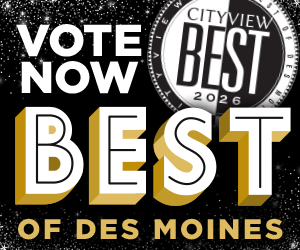Drag queens of Des Moines bare all about…
11/13/2013
Photo by Billy Dean Porter
This may be the only time you’ll see drag queens compared with professional wrestlers, but here you go: When looking at both groups — even if you’re a fan of either of them — it’s sometimes easy to write them off as merely the sum of their parts. Wrestlers portray themselves as large, angry brutes; drag queens are flashy, effeminate and often biting in their humor. But in both cases, genuine people lay beneath the veneers. And just like how The Rock probably buys kitty litter and Hulk Hogan has an AARP card, the capital city is populated by store managers and waiters and boyfriends and brothers who sometimes put on makeup and go by names like Kata Klysmic or Kim Chee or the absolutely amazing Jupiter Phuckit.
So we wanted to find out what it was all about. What made them decide to perform, how do they see themselves, and what makes a queen a queen? We wish we could have talked to them all, but the following snapshots are a fine primer.
Tyona Diamond:
‘feeling that change’
 Tyona Diamond serves as the show director at Le Boi, a gay bar at 508 Indianola Ave. Like many a drag queen, Diamond was originally reluctant to take the plunge.
Tyona Diamond serves as the show director at Le Boi, a gay bar at 508 Indianola Ave. Like many a drag queen, Diamond was originally reluctant to take the plunge.
“When we first opened (Le Boi), we were deciding what to do to bring people in,” Diamond recalled. “Of course drag is one thing that will always bring people to the bar.”
“Watching shows, it’s not something that I wanted to do,” Diamond continued. “I said before that I would never get in drag. A lot of people say that, but then they do it and feel that change. The reaction and the people cheering for you makes you feel special.”
Now Diamond maintains an active performance schedule (“at least twice a week,” she said) and keeps the entertainment fresh at Le Boi. Starting in December, Diamond will emcee “Tyona’s Drag Race,” a weekly elimination-style competition between 18 drag queens where the winner takes home a $1,000 cash prize.
Another part of Diamond’s job at Le Boi is keeping the drag shows hopping, which means she keeps her eyes peeled and ears perked in search of new talent.
“I like to watch them first,” she said of performers hoping for a slot in a show. “They can look really good, but when they get on stage, they don’t have it. So (it’s also about) how well they perform, how the audience reacts to them. We have open stage here on Thursday nights where anybody can perform, so I like to watch those.”
Despite the healthy competition across the city, Diamond said the atmosphere within the scene is friendly and supportive.
“We help each other out,” she said. “Someone new might say, ‘Hey, I’m interested in getting into drag, can you help me,’ and we will because we’re all basically friends.”
Every queen will mention a different motivation for performing. Often times the reason for first getting on stage and the one for actually staying there are different. For Diamond, her initial involvement was out of professional necessity, but she keeps doing it because of the way it makes her feel.
“Being a boy, you don’t get to address that aspect of yourself often. But every time you go on stage, you kind of create that character. That’s why I like it. Every time you get on stage, you can be whoever you want to be.”
Just like being born into the world the first time, acquiring a new identity with a chosen and deliberate rebirth all starts with a name. Selecting the name that best suits is a personal process that acts as a reflection not only of the persona on stage, but of the person doing the performing.
“I had people help me pick out my name,” Diamond confessed. “When I first started, I had this whole group of people, and we came up with 50 names.
“Some drag queens like to be funny; others like pretty names. For me, my name is Ty, and Tyona Diamond sounds like Ty-own-a-diamond, so it’s kind of a play. It’s a hard process, because it’s stuck with you. Some queens will change their names every two months.”
She thinks for a moment.
“I guess they’re trying to still find themselves.”
Without such entangled identity issues, now that she’s settled into her new name and has found who she “wants to be,” Diamond relishes the chance to do more than just perform. Drag queens are often the first thing many straight people think of when conjuring up mental images of “the gays” or the Lesbian-Gay-Bisexual-Transgender (LGBT) lifestyle. Voluntarily or not, drag queens will often serve as ambassadors of sorts and are sometimes the first point of contact bridging a town’s gay and straight communities. That is a role Diamond revels in and is quick to embrace.
“We do a lot for the community,” she explained. “Not just entertaining, but we do a lot of benefits. Being a drag queen, we have that voice. If we say something, it’s a little bit louder. It’s not all about being on stage. It’s helping out the community.”
So while Ty may never have planned on getting on stage, Tyona Diamond will continue to cast a shadow in the spotlight.
“It’s something that I really enjoy doing at the moment,” she said. “Right now, I can see myself doing it for a while.”
Candace Cass:
‘creating the illusion’

Photo by Alisabeth Van Presley
“There are people out there who want to be women, who feel like they were born in the wrong body,” Candace Cass said, sipping from a mug at a downtown coffee shop. “I am not one of those people.”
Despite being just 27, Cass is a veteran voice in Des Moines’ drag queen community.
“I started doing drag in 2006 for Halloween, which I think is most people’s way to start,” she recalled. “Then a friend recommended that I run in this pageant, so I did and took second place. (But) it was close to a year after that before I started performing.”
Even after a performer makes the commitment to take the stage, confidence is not instilled overnight. Often a performer (Cass prefers “female impersonator” to the more colloquial “drag queen”) will spend the first several months on stage getting used to the idea of being on stage. Even the performers with backgrounds in theater or dance will have an adjustment period. And, of course, Cass said this: The simple act of being born gay doesn’t automatically instill into a performer a perfect understanding of one’s own world. Through the makeup and outfits and larger-than-life personalities, it can be easy to forget that each one of these performers is a person — often a very young person — and a work in progress who’s still trying to find his or her own way through life, which is true of most people, gay or straight.
“At first I didn’t really talk to anybody about (performing) too much,” Cass said. “I think I had to get comfortable with the idea myself. I come from a small town in Missouri, so I didn’t really know much about it myself when I started. My first impression was, ‘Why are they dressed as women? Do they want to be women?’ And, of course, it’s not like that. There are some transgendered people, but that’s a whole other aspect. I’m a boy. I love being a boy.”
Being a female impersonator is a bit like being a magician. Both create an illusion — a charm that requires a lot of work behind the scenes before that illusion is ready to present to the world.
“It’s a game of hiding things and bringing things out,” Cass explained. “You want to hide everything manly about you, and either bring out your feminine features or create the illusion of feminine features.”
It’s a process.
“We wear hip pads. Some people wear butt pads, but I don’t have to,” Cass smiled coyly. “But the shape of my body — breasts, hips — is all created. Some people literally use couch cushions. I just go to the fabric store and buy two- or three-inch foam. Then I’ll draw out the shape I want and just use a carving knife to cut out pieces to attach to my body to give the illusion of a woman’s body. Then comes the tights; I wear five pairs of tights, because it makes the pads conform to my body, so there’s no lines or anything, just a smooth, hourglass figure.
“Then, of course, there’s duct tape, which is always fun. I don’t think I really need to go into much detail about that.”
The result is convincing.
“My sisters are jealous because they think I’m prettier than they are,” she said with a smile. “I’m like, ‘It’s all make up. Don’t be too jealous.’ ”
While Cass never tried to hide her on-stage persona when she first started performing, she didn’t always tell people about it because she didn’t know how to necessarily explain it. But those days are gone.
“I recently just told my dad. I’d actually sent him some pictures, and he was like, ‘Hey, who’s that hot chick?’ And I was like, ‘Dad, that’s me; don’t ever say that again.’ ”
Much like Diamond, Cass enjoys the role of emissary. She likes the possibility of being someone’s first contact with drag or even with an openly gay person.
“I went to a little town in Missouri,” she recalled. “It was the first drag show ever there, and they sold tickets to it. The turnout was amazing. Most of the people in there were straight and, for a lot of them, that was their first time at a drag show. It was really cool to see them all so exited and interested in something they’d never seen before.
“They were entertained.”
A smile lifted her cheekbones.
“I really enjoyed that.”
Kata Klysmic:
‘giving ’em something to talk about’

Photo by Billy Dean Porter
Kata Klysmic is a relative newcomer to the drag scene, but she’s approached her art with a focused determination. The results have been meteoric.
“I’m a quick learner,” she insisted.
This past March, Klysmic was named Miss Blazing Saddle, making her the poster child of the venerable East Village bar. That summer she was named Miss Capital City. Then, on Oct. 11, Klysmic was named Miss Gay Iowa for 2014. Not bad for someone who started performing in January.
“I consider it an art form,” Klysmic said of drag. “It’s a form of expression and entertainment. It’s a conversation starter for people who watch, which I think all art should be. That’s what it is for me; it’s a way to get people to talk.”
Off stage, the 26-year-old is in a state of perpetual motion. Klysmic sees drag not only as a means of keeping busy, but as a vessel for improvement — both of herself and the community around her.
“People would always ask me, ‘Why do you look so bored? Are you having fun?’ So finally I just decided I wanted a way to just change everything. I wanted to be more outgoing and change everything in the most positive way possible. And (drag) has been my way to be creative and be involved in the community doing benefits and raising money — just getting involved.”
That’s why she takes her titles so seriously and why she approached the stage for the first time in such a deliberate manner.
“I took the month of January just to prep,” she explained. “I really did my research and had everything ready before I presented myself. So, really, I came out as fully-blossomed as I could — Facebook, photo shoot, everything was done.
“I used my resources. I knew people at Le Boi and the Saddle, and they gave me a chance. I think, frankly, they doubted me a bit, but I just made sure that I was ready, and I came out the best I could.”
She came out on top, in fact. And now that she’s won, she’s approaching the legacy with the same intense desire to lead by example. Klysmic understands that it’s neither possible nor desirable to be gay in a void. And she views her titles — and the visibility that comes with them — as a pulpit from which to reach out and affect change, both within and beyond the LGBT community.
“When I won Miss Blazing Saddle, I wanted to represent that bar really, really well,” she said. “I wanted to be a positive model and show people that you don’t have to be a snarky person to get anywhere.
“Then, winning Miss Gay Iowa, now I’m in the spotlight for the entire state. People read what I have to say. And I’m glad. I want them to watch me. I want them to see that you can be successful and not be a bitch about it. You can be a role model. Otherwise why would the straight community want to support us if all they see are a bunch of snarky queens? If (drag queens) are the first thing they think of and the first thing their interested in, is it, ‘Oh yeah, that’s a (positive) thing,’ or is it, ‘Oh, that’s a bunch of snooty boys in dresses?’ ”
The gradual changing of actions within the community — and external perceptions of it — is a cause that Klysmic intends to continue fighting for long after new title-holders have been crowned.
“You represent that title forever,” she said. “I’ll be Miss Blazing Saddle forever, and I’ll make sure that the next Miss Blazing Saddle is the best, and the one after that is living up to expectations. I’m always going to have my eye on it, just like Miss Gay Iowa. When I step down, I want to make sure that the next one is just as prepared, is doing what she needs to do to represent the people. It’s always going to be important to me. When you put so much energy into something for so long, you can’t help but want to nurture it and make it grow.
Klysmic is part of a legacy in Des Moines, as are Cass and Tyona — each in her own way. They are members of generations of LGBT professionals and performers who have come and are yet to emerge, shining in creative, artistic glory by emulating the beauty of natural art and history — the female form. And they show the world that we really can choose who we want to be.
“When a straight person walks into the Saddle, I’m a representative for my people — for my friends and the gay people of this state. So I want to be sure that people know that I’m the same as you. Except I’m a dude in a dress.” CV
















I am new to the city (from michigan)
Is there a gathering of transgenders there or where ?
Day? Time? Details?